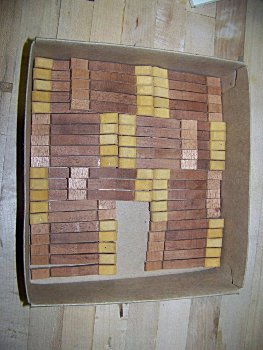
New hammer shanks for an 1890s Chickering grand

Measuring elastic deflection for stock selection
Piano actions have more parts than the rest of a piano, and every part has variations, by design, for purposes of improvement, or through manufacturing tolerances. Both a technical knowledge and an intuitive understanding of mechanics are necessary to combine these parts, and each separate assembly into a single musical unit.
In many pianos the keys and actions are based on common parts, and modern tools allow their performance to be analyzed in detail to adjust them much closer to the musician's wishes, however in pianos where the parts are special or unavailable designs, or where their function is compromised, fewer solutions are readily available.

New adjustable hammer flanges for a square piano

New underhammers for a square piano
Action parts
I make wooden and many metal action parts in small and medium sized batches, from ten to several hundred or even a thousand. Usually these will reconstruct the manufacturers original intent and specifications in order to replace damaged, missing or replaced parts, but I can easily redesign poorly implemented actions or build from scratch to fulfill specific requirements. I use appropriate materials, often with wood harvested a century ago, and furnish the parts with correctly prepared cloth, felt and leather.
I don't hand craft each part one at a time. I've equipped my workshop with machines with reference to old patents and tool marks in order to produce the most consistent and accurate results so that my parts can be easily installed and regulated with a minimum of rework. I make measured drawings, durable machine fixtures and often dedicated cutters for each new part so that another batch can be set up quickly.
Hammer work
Action work is ultimately concentrated in the hammers. I generally don't make these, but I prepare new, bought-in hammers for installation completely: I bore them for consistent striking distance and angle, adjust their weights for even dynamic response, and in grands shape them for even checking and release, and finally voice them for the most appropriate tonal range for each piano.

Preparing to drill for balance rail pins on a new keyboard

Separating the fronts of keys on a new keyboard with old two piece ivory keytops
Key work
Keys are the largest, heaviest and most visible part of the musical and mechanical interface with a piano, and though they're the basis for the feel and responsiveness of the piano often their effects are hidden from the performer in an overall compound of leverage, weight, voicing, soundboard function and string termination. When I fix normal key wear and damage I examine each key mechanically as well as visually, and can adjust them to perform better, from simply evening out key weights to correcting problems with leverage, stiffness, inertia and any other power transmission issues.
When keys are damaged, missing or defective I can make individual replacement keys as well as whole keyboards to fit original or new keyframes. I have special tools for this purpose as well as for reconditioning keys, and I remove bushings and ivory cleanly and without damage, and can replace most missing pieces with ones that match.